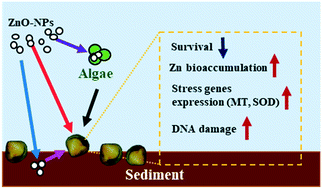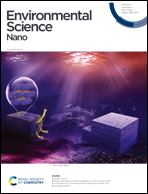Co-exposure to foodborne and waterborne ZnO nanoparticles in aquatic sediment environments enhances DNA damage and stress gene expression in freshwater Asian clam Corbicula fluminea†
Abstract
The widespread usage of ZnO nanoparticles (ZnO-NPs) and their potential to accumulate in sediment have raised great concerns regarding their chronic ecotoxicity in benthic ecosystems. This study investigated the effects of ZnO-NPs on the freshwater Asian clam Corbicula fluminea exposed to the nanoparticles through various routes in aquatic sediment environments. Significant amounts of Zn accumulated in the single-celled algae Chlorella ellipsoidea exposed to ZnO-NPs, resulting in foodborne exposure for C. fluminea. In addition, Zn was analyzed in overlaying water, pore water, and sediment in aquatic sediment environments and was found to accumulate mostly in sediment. Co-exposure to foodborne and waterborne ZnO-NPs significantly increased the mortality in C. fluminea compared to the mortality in clams exposed to untreated algae (about two-fold increase on day 28). Further evidence showed that bioaccumulation (about 1.5-fold increase), the expression of stress genes (about 1.5-fold increase), and DNA damage (about two-fold increase) were significantly enhanced in C. fluminea upon co-exposure to foodborne and waterborne ZnO-NPs compared with the levels in untreated algae on day 14. This study helps broaden the understanding of the ecotoxicity of ZnO-NPs and their interactions with sediment, algae, and bivalves in benthic ecosystems.



 Please wait while we load your content...
Please wait while we load your content...